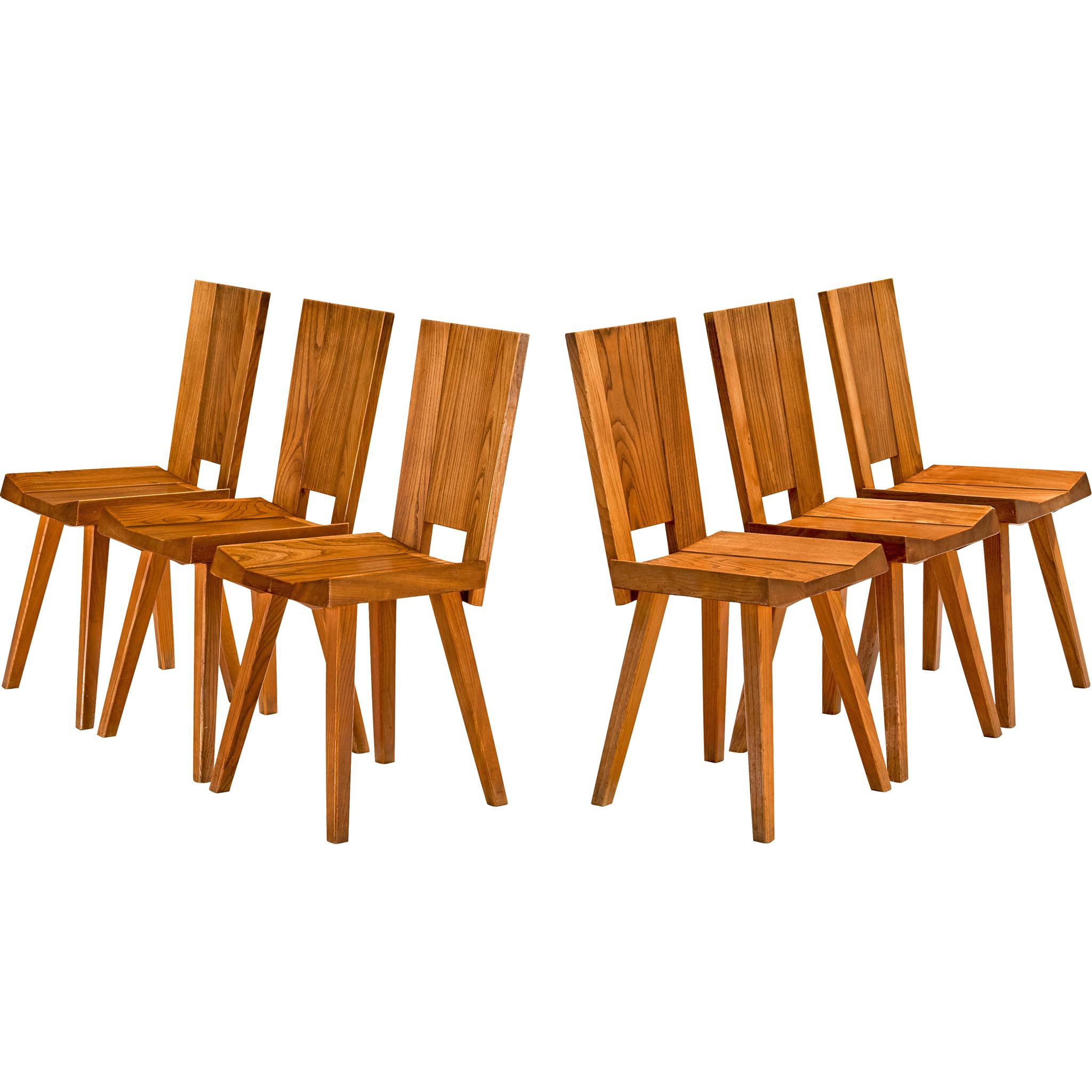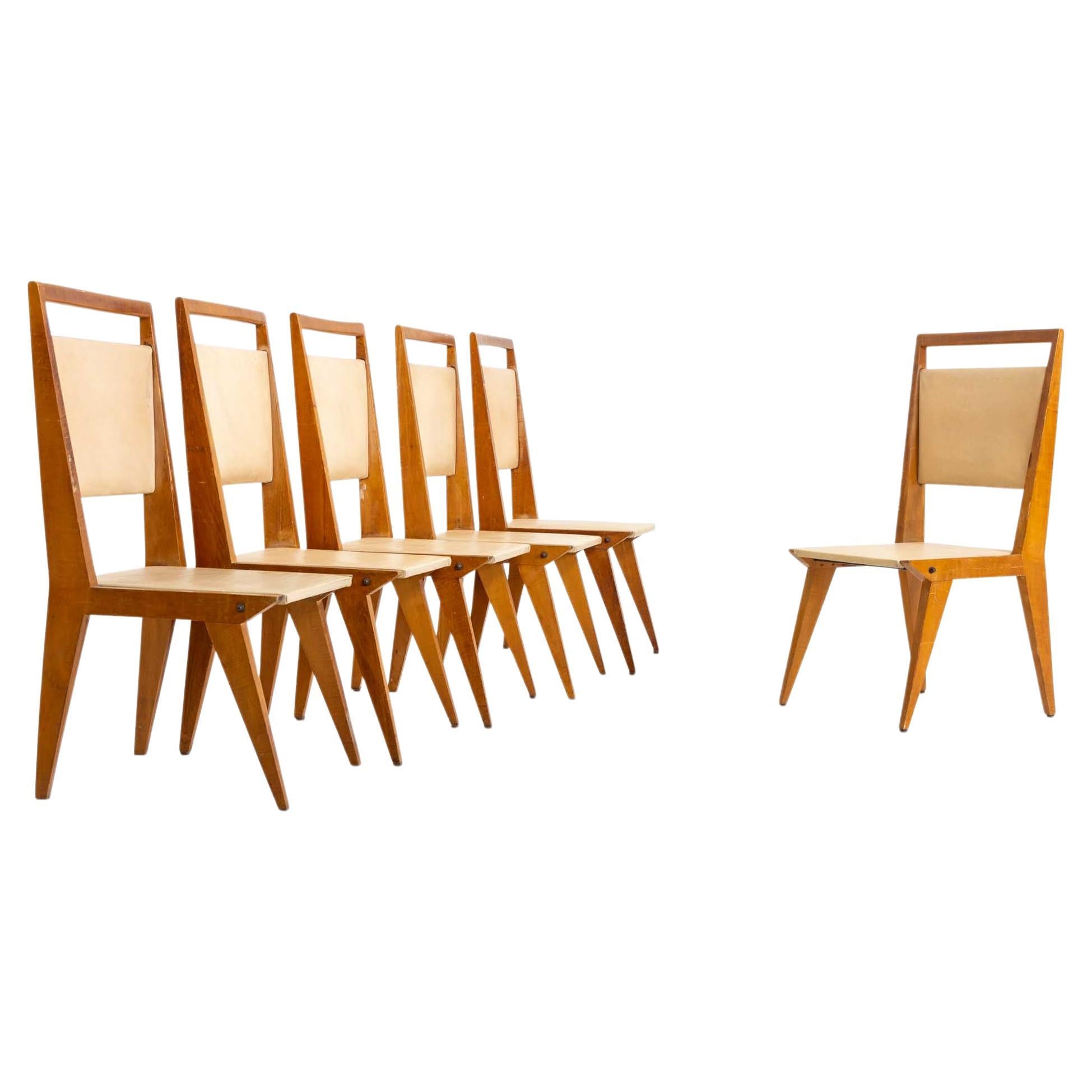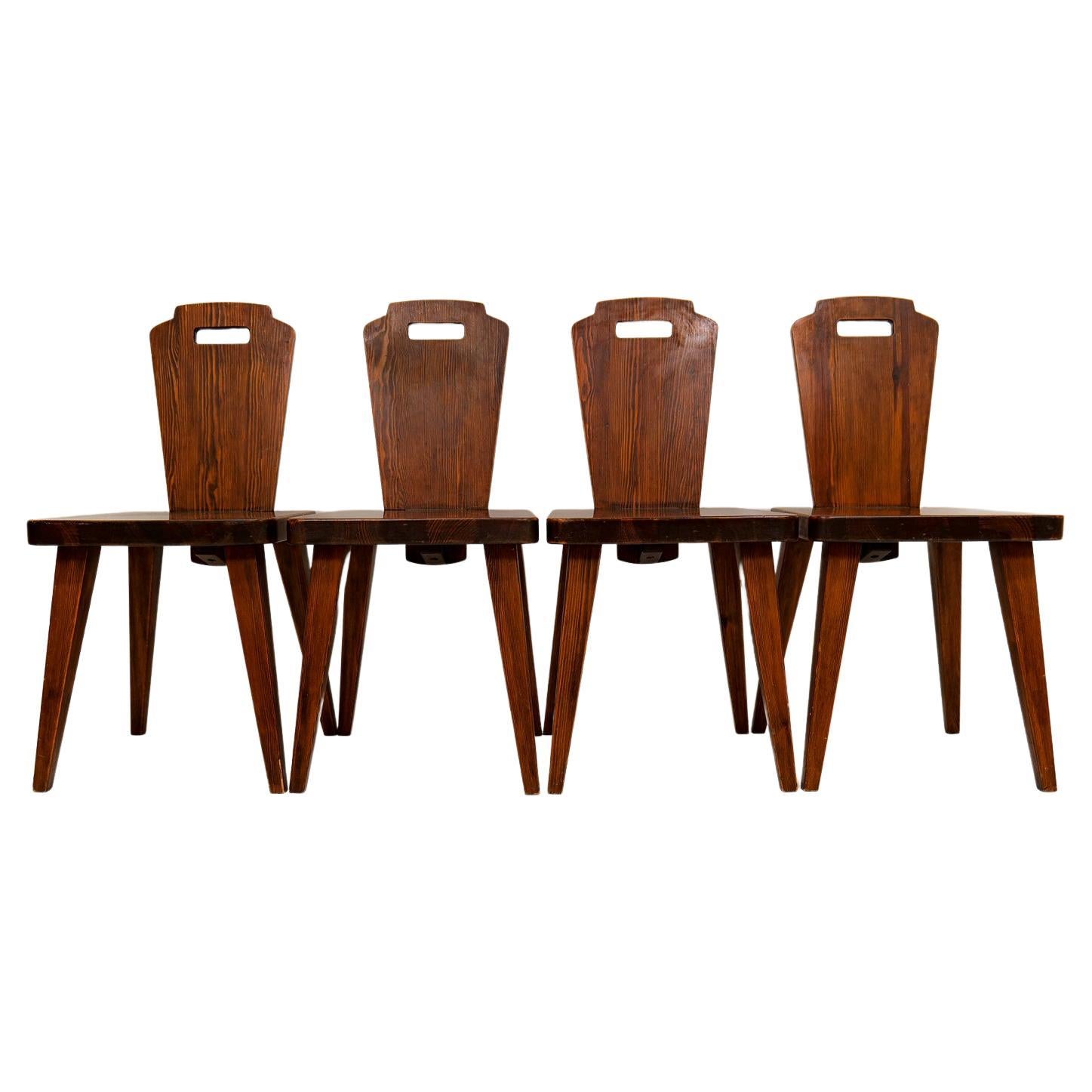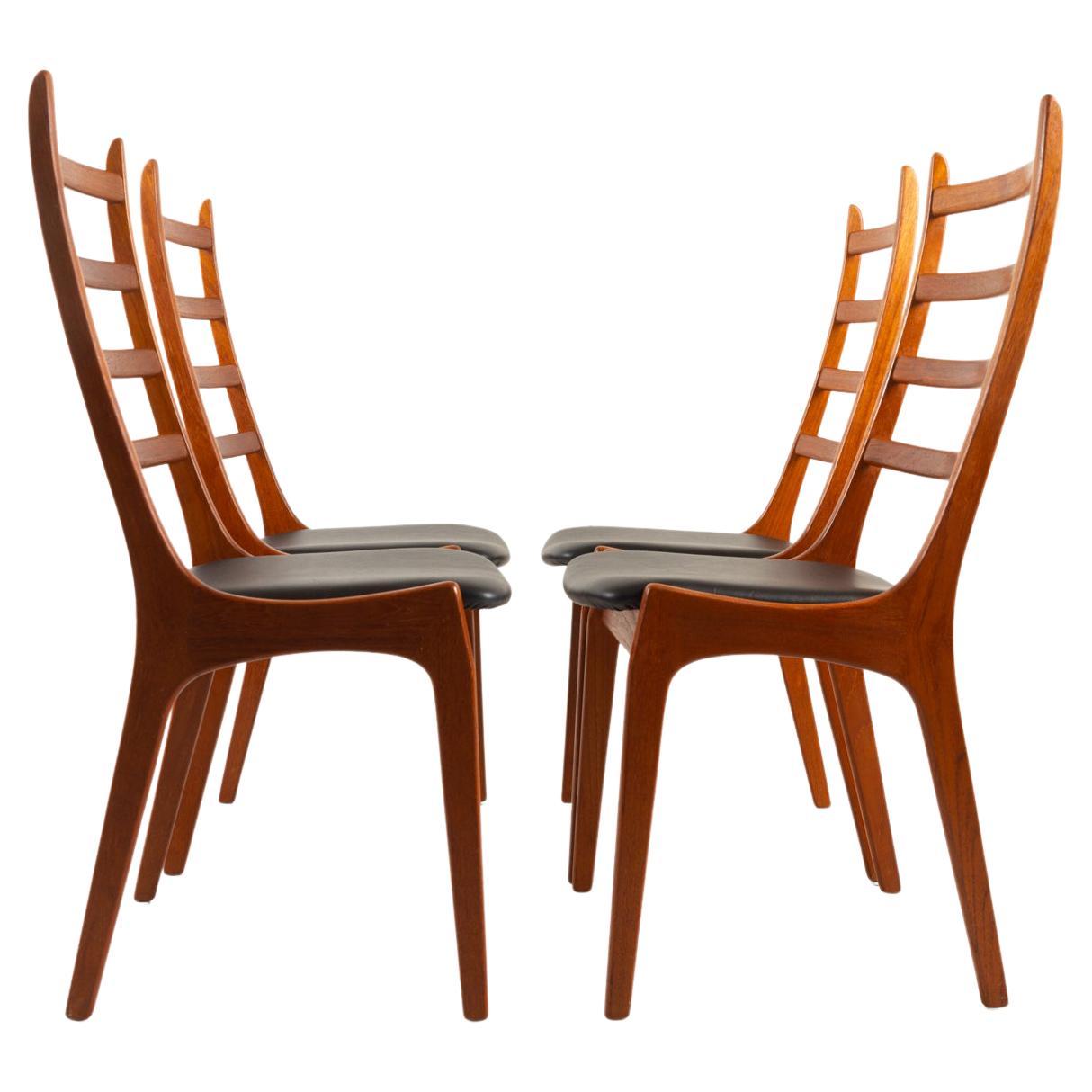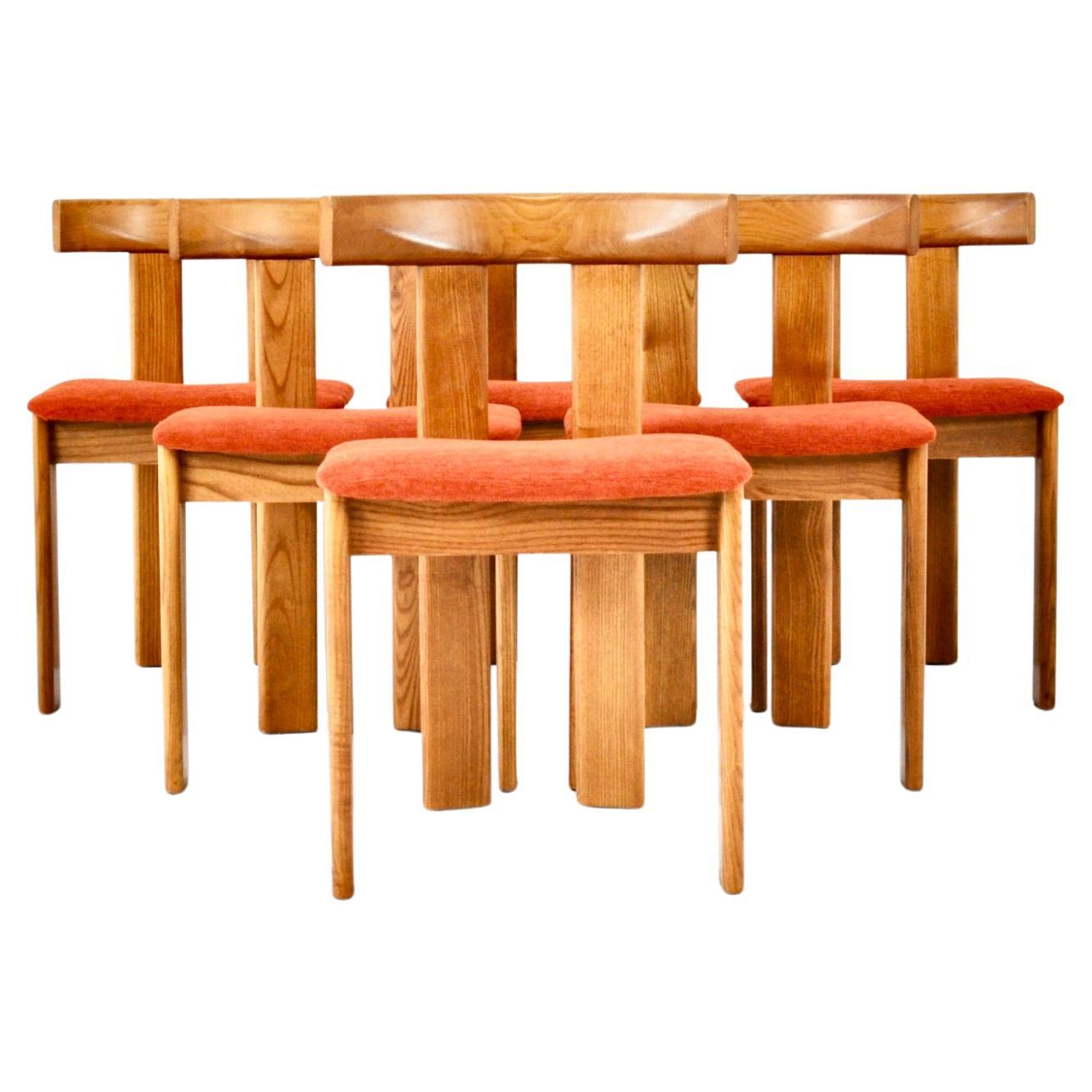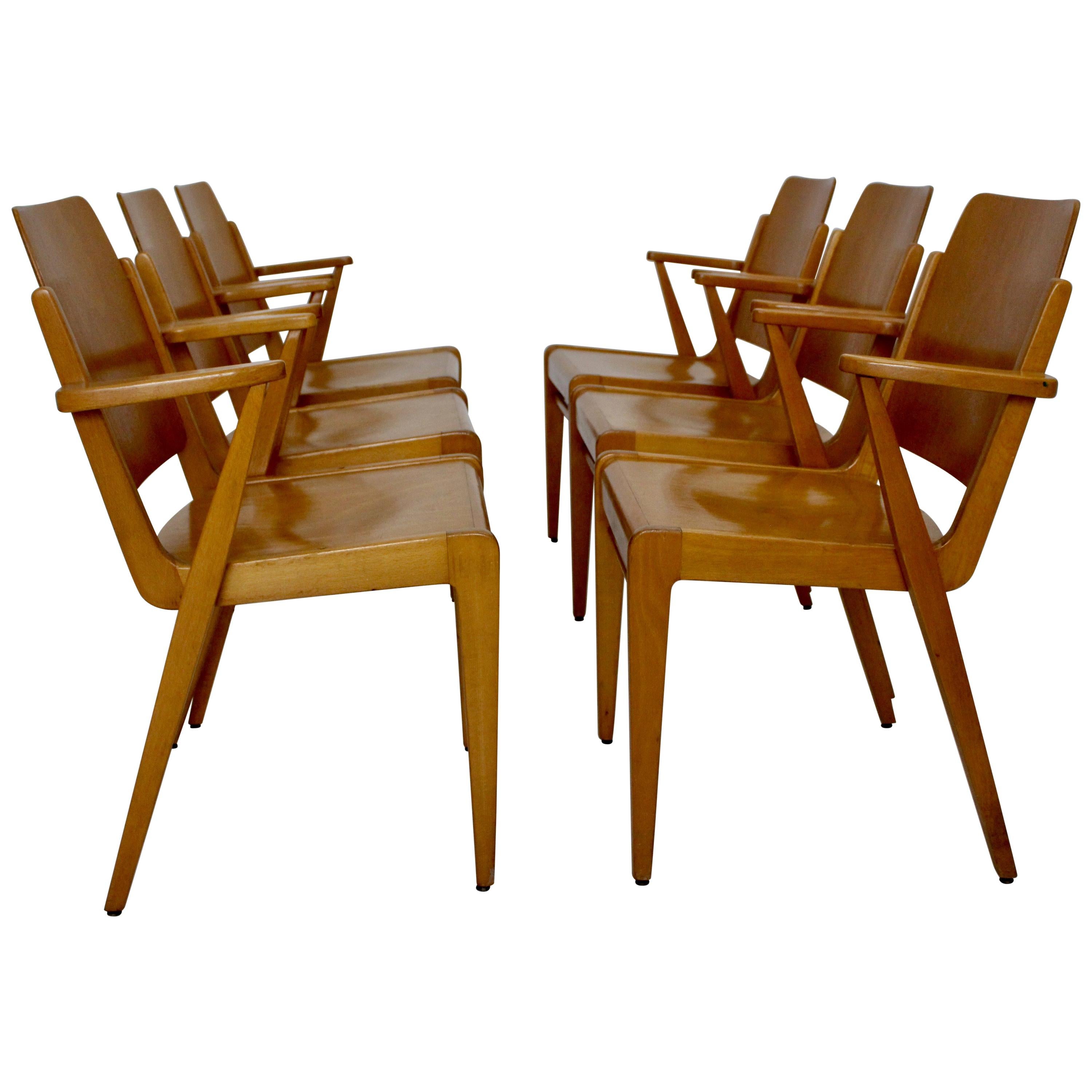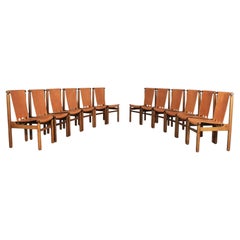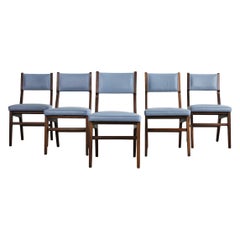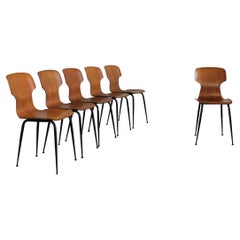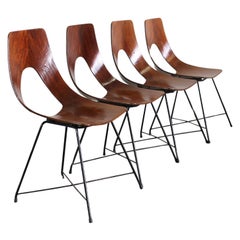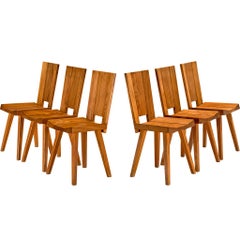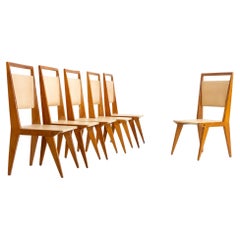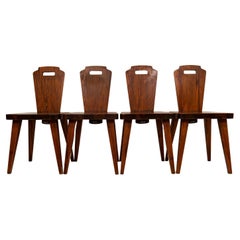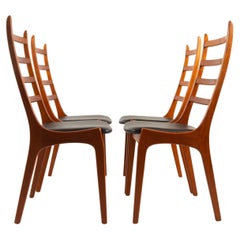Items Similar to Set of Six Dining Chairs in Wood by Sineo Gemignani Italian Manufacture 1940s
Video Loading
Want more images or videos?
Request additional images or videos from the seller
1 of 19
Set of Six Dining Chairs in Wood by Sineo Gemignani Italian Manufacture 1940s
$7,195.07per set
£5,352.41per set
€6,000per set
CA$9,852.52per set
A$10,954.66per set
CHF 5,719.92per set
MX$133,344.86per set
NOK 72,983.66per set
SEK 68,382.20per set
DKK 45,674.69per set
Shipping
Retrieving quote...The 1stDibs Promise:
Authenticity Guarantee,
Money-Back Guarantee,
24-Hour Cancellation
About the Item
A very rare set of six dining chairs entirely made in curved wood, this set was designed by the Italian artist Sineo Gemignani and manufactured in Italy during the 1940s.
The artist was born in Livorno on 30 July 1917, but around the early 1920s, the family was forced to return to the places of origin of his father (San Pantaleo near Vinci) because of his political activity that had attracted the attention of the fascist. Here the little Sineo is directed to the study of art by his master Virgilio Gandi. The family then moved to Empoli, where Sineo spent the rest of his life and died prematurely on May 22, 1973.
Sineo Gemignani trained artistically at the Royal Art Institute of Porta Romana in Florence, where, in those years they taught important masters such as Libero Andreotti, Gianni Vagnetti, Pietro Parigi, Giuseppe Lunardi.
In those years a reference figure for the artist’s training was also the Empoli painter Virgilio Carmignani.
Entrusted to the tutelage of Carmignani, Sineo began to frequent the group of painters from Empoli, composed among others by Ghino Baragatti and Mario Maestrelli.
Always during the period spent at the Art Institute was born the deep and fraternal friendship with Dilvo Lotti, talented painter of San Miniato, friendship that will be interrupted only with the death of Sineo.
After completing his studies, in 1939, he was enlisted in the Italian Army, thus beginning a long period that led him to fight in the Balkans (1942). In August 1944 he participated in the liberation of Florence and in February 1945 he enlisted as a volunteer, taking part in the operations for the liberation of northern Italy with the Mantua Combat Group. These years are documented by numerous drawings and engravings that describe the tragic events of which he was a participant and that testify how the civil commitment is intertwined with the artistic vocation of Sineo.
Between 1946 and 1949 he made short stays in Milan, where he collaborated with his friend Ghino Baragatti on the decoration of the atrium of the new cinema-auditorium in the Galleria Manzoni. During his stay in Milan he came into contact with a stimulating climate, met painters and gallerists and reflected on the abstract currents, as evidenced by various paintings of that period. But he feels that all this does not belong to him and takes the path of realism.
In the 1950s Gemignani began the central decade of his activity as an artist and as a man, as he actively participated in the cultural and political life of Empoli. They are years of intense work, especially with the technique of mural painting and in particular, in the form of the fresco torn and brought to the table. There are numerous participations in collective exhibitions and artistic initiatives, earning awards and recognitions.
In 1958 he also began his teaching activity in the Art Institutes of Florence (1958-1960), Siena (1960-1964), Pisa (1964-1973) in which he teaches drawing from life. He participates in various competitions for the realization of public works.
In the following decade, he devoted himself to the research of new expressive techniques, in particular in the field of engraving, practicing especially in portraits. In painting, however, he is increasingly oriented towards the observation of daily life, even in the most modern aspects. Works focused on sports, caricature portraits, life on the beach took shape.
In the last phase of his life, he dedicated himself in particular to the realization of a project with a chivalrous subject. From the second half of the 1960s he began the preparatory study for the realization of a large fresco for the decoration of the living room of a private home. The chosen subject was taken from a heroic poem by Ippolito Neri entitled La Presa di San Miniato. Of the project, which remained unfinished due to the death of Sineo, there remain the preparatory cardboard for the fresco and numerous drawings that served to paint the last of his wall paintings, The Battle of Montaperti in 1971, commissioned by the Circolo Farinata degli Uberti of Empoli.
In 1974 the first retrospective entitled to Sineo Gemignani was held at the Palazzo delle Esposizioni in Empoli.
In 1995, at the Convent and Church of Santo Stefano degli Agostiniani in Empoli, the artist’s solo exhibition was inaugurated, which constitutes an important moment of critical reflection on his artistic production.
- Creator:Sineo Gemignani (Designer)
- Dimensions:Height: 40.95 in (104 cm)Width: 18.12 in (46 cm)Depth: 17.33 in (44 cm)Seat Height: 17.72 in (45 cm)
- Sold As:Set of 6
- Style:Mid-Century Modern (Of the Period)
- Materials and Techniques:Wood,Other
- Place of Origin:
- Period:
- Date of Manufacture:1940s
- Condition:Wear consistent with age and use.
- Seller Location:Montecatini Terme, IT
- Reference Number:1stDibs: LU5304225685842
About the Seller
4.9
Vetted Professional Seller
Every seller passes strict standards for authenticity and reliability
1stDibs seller since 2020
123 sales on 1stDibs
Typical response time: 1 hour
- ShippingRetrieving quote...Shipping from: Florence, Italy
- Return Policy
Authenticity Guarantee
In the unlikely event there’s an issue with an item’s authenticity, contact us within 1 year for a full refund. DetailsMoney-Back Guarantee
If your item is not as described, is damaged in transit, or does not arrive, contact us within 7 days for a full refund. Details24-Hour Cancellation
You have a 24-hour grace period in which to reconsider your purchase, with no questions asked.Vetted Professional Sellers
Our world-class sellers must adhere to strict standards for service and quality, maintaining the integrity of our listings.Price-Match Guarantee
If you find that a seller listed the same item for a lower price elsewhere, we’ll match it.Trusted Global Delivery
Our best-in-class carrier network provides specialized shipping options worldwide, including custom delivery.More From This Seller
View AllIlmari Tapiovaara Set of Twelve Dining Chairs by Permanente Mobili Cantù 1950s
By La Permanente Mobili Cantù, Ilmari Tapiovaara
Located in Montecatini Terme, IT
Set of twelve dining chairs with wooden frame, seat and back in leather designed by Ilmari Tapiovaara and produced by La Permanente Mobili Cantù in 1950s.
This set of chairs presen...
Category
Vintage 1950s European Mid-Century Modern Chairs
Materials
Leather, Wood
Gio Ponti (Attributed to) Set of Five Chairs in Wood and Leather by ISA Bergamo
By Gio Ponti, I.S.A. Italy
Located in Montecatini Terme, IT
A set of five dining chairs with a structure in wood, seat, and back in padded leather, produced by the Italian manufacturer ISA Bergamo the design of this set is attributed to Gio P...
Category
Vintage 1950s Italian Mid-Century Modern Chairs
Materials
Leather, Wood
$10,193 / set
Free Shipping
Carlo Ratti Set of Six Chairs in Plywood by Industria Legni Curvati Lissone 1950
By Carlo Ratti, Industria Legni Curvati
Located in Montecatini Terme, IT
Set of six dining chairs with backs and seats realized in curved veneered plywood and legs in black lacquered metal, designed by Carlo Ratti and manufactured by Industria Legni Curvati (Lissone, Italy) in the 1950s.
In Italy, at the beginning of the XX century, industries of curved solid wood arose under license of Michael Thonet, and through the International Exhibitions the processing of curved wood became more and more widespread.
The Expo of the first decade was also attended by the wood manufacturers of Monza, while in 1905 Otto Helzer, in Switzerland, patented wooden structures in curved laminated, whose strength was equivalent to those in steel.
The Ratti brothers of Monza took their cue from the solid wood laminate to create furniture that, instead of wooden elements, used sheets of wood.
The brothers Ratti, Carlo and Mario, also began to follow the young artistic avant-gardes (cubism, futurism and abstractionism).
The mastery of wooden sculpture influenced Carlo in the design and realization of furniture of fine neo-plastic artistic workmanship and decò, receiving honors from the Prince of Piedmont Umberto di Savoia.
In 1919, in Milan, the first Lombard Exhibition of Decorative Arts was set up (later to become the Triennale) and the Ratti brothers exhibited their furniture in solid wood but also in curved panel with a new system of curvature, the one in Telo.
The canvas system was developed by the Ratti brothers with the help of a friend, Cesare Cantù.
They developed an elastomer bag in which the mould was inserted with the panel to be bent and, closing it with clamps, the air inside was removed, thus making the panel adhere to the mould.
Carlo and Mario found in the Telo system a means by which they could make objects and furniture in the three spatial directions with large surface curvatures, without limits of thickness and minimum radii of curvature.
In 1921 in Stuttgart the first Salone del Mobile was inaugurated and the Fratelli Ratti of Monza made itself known internationally by presenting solid wood furniture and also furniture in load-bearing plywood, flanked by furniture with framed and interchangeable covers.
The Expo became meeting places to verify and present the novelties in the furniture and industrialization sector and, with the development of Industrial Design, the first architects joined in the design of the furniture industries.
The Ratti Brothers, in the various international and national exhibitions, also presented incredible objects in their realization with the system in Telo.
After 1930 Carlo and Mario produced many containers for radio and folding chairs for cinema but in 1939 they divided and in Monza Mario remained who, with his sons Antonio and Angela, formed the Società Compensati Curvi...
Category
Vintage 1950s Italian Mid-Century Modern Chairs
Materials
Metal
Augusto Bozzi Set of Four Ariston Chairs in Plywood and Metal by Saporiti 1950s
By Fratelli Saporiti, Augusto Bozzi
Located in Montecatini Terme, IT
Set of four dining chairs model Ariston with structure in curved plywood and black lacquered metal legs.
The Ariston chair was designed by Augusto Bozzi and manufactured by Saporiti...
Category
Vintage 1950s Italian Mid-Century Modern Chairs
Materials
Metal
Carlo Ratti Set of Four Chairs in Plywood by Società Compensati Curvi 1950s
By Carlo Ratti, Società Compensati Curvati
Located in Montecatini Terme, IT
Set of four dining chairs with a frame in black lacquered metal and seat in curved plywood, attributed to Carlo Ratti and produced by Società Compensati Curvati in the 1950s.
In Italy, at the beginning of the XX century, industries of curved solid wood arose under license of Michael Thonet, and through the International Exhibitions the processing of curved wood became more and more widespread.
The Expo of the first decade was also attended by the wood manufacturers of Monza, while in 1905 Otto Helzer, in Switzerland, patented wooden structures in curved laminated, whose strength was equivalent to those in steel.
The Ratti brothers of Monza took their cue from the solid wood laminate to create furniture that, instead of wooden elements, used sheets of wood.
The brothers Ratti, Carlo and Mario, also began to follow the young artistic avant-gardes (cubism, futurism and abstractionism).
The mastery of wooden sculpture influenced Carlo in the design and realization of furniture of fine neo-plastic artistic workmanship and decò, receiving honors from the Prince of Piedmont Umberto di Savoia.
In 1919, in Milan, the first Lombard Exhibition of Decorative Arts was set up (later to become the Triennale) and the Ratti brothers exhibited their furniture in solid wood but also in curved panel with a new system of curvature, the one in Telo.
The canvas system was developed by the Ratti brothers with the help of a friend, Cesare Cantù.
They developed an elastomer bag in which the mould was inserted with the panel to be bent and, closing it with clamps, the air inside was removed, thus making the panel adhere to the mould.
Carlo and Mario found in the Telo system a means by which they could make objects and furniture in the three spatial directions with large surface curvatures, without limits of thickness and minimum radii of curvature.
In 1921 in Stuttgart the first Salone del Mobile was inaugurated and the Fratelli Ratti of Monza made itself known internationally by presenting solid wood furniture and also furniture in load-bearing plywood, flanked by furniture with framed and interchangeable covers.
The Expo became meeting places to verify and present the novelties in the furniture and industrialization sector and, with the development of Industrial Design, the first architects joined in the design of the furniture industries.
The Ratti Brothers, in the various international and national exhibitions, also presented incredible objects in their realization with the system in Telo.
After 1930 Carlo and Mario produced many containers for radio and folding chairs for cinema but in 1939 they divided and in Monza Mario remained who, with his sons Antonio and Angela, formed the Società Compensati Curvi...
Category
Vintage 1950s Italian Mid-Century Modern Dining Room Chairs
Materials
Metal
$7,428 / set
Free Shipping
Augusto Bozzi Set of Two Ariston Chairs in Plywood and Metal by Saporiti 1950s
By Augusto Bozzi, Saporiti
Located in Montecatini Terme, IT
Set of two dining chairs model Ariston with structure in curved plywood and black lacquered metal legs.
The Ariston chair was designed by Augusto Bozzi and manufactured by Saporiti ...
Category
Vintage 1950s Italian Mid-Century Modern Chairs
Materials
Metal
You May Also Like
Atelier C. Demoyen Set of Six Chairs in Solid Elm
Located in Waalwijk, NL
Atelier C. Demoyen, set of six dining chairs, solid elm, France, 1970s
Atelier C. Demoyen (Claude de Moyen) gained prominence as a workshop recognized for crafting, among others, Pi...
Category
Vintage 1970s French Mid-Century Modern Dining Room Chairs
Materials
Elm
Dining Chairs, Designed by Vittorio Armellini, Italy, Mid-20th Century
Located in Greding, DE
Set of six dining chairs upholstered in yellow leatherette on wooden frame. Signs of age and use. Designed in the mid-20th century for a studio by architect Vittorio Armellini...
Category
Mid-20th Century Italian Modern Dining Room Chairs
Materials
Wood
Swedish Modern Dining Chairs in Pine Attributed to Bo Fjaestad, 1940s
By Carl Malmsten
Located in Hillringsberg, SE
Stained pine dining chairs attributed to Bo Fjaestad, Sweden.
Similar to the "cabin style" furniture these chairs were bought in Arvika, the hometown of B...
Category
Vintage 1940s Swedish Mid-Century Modern Dining Room Chairs
Materials
Pine
Vintage Danish High-Back Teak Dining Chairs by Korup Stolefabrik 1960s, Set of 4
By Korup Stolefabrik
Located in Asaa, DK
Vintage Danish teak dining chairs by Korup Stolefabrik 1960s, Set of 4.
Set of Danish Mid-Century Modern ladder back dining chairs in solid teak with new upholstery in black faux le...
Category
Vintage 1960s Danish Mid-Century Modern Dining Room Chairs
Materials
Teak
Dining chairs by Luigi Vaghi for Former, 1960s, set of 6
Located in bruxelles, BE
Set of 6 wooden chairs with red-orange fabric seats by Luigi Vaghi. Seat height: 45 cm. Wear due to age and age of chairs.
FOR SHIPPING, REQUEST US FOR RECEIVE THE BEST PRICE
Category
Vintage 1960s Italian Mid-Century Modern Chairs
Materials
Fabric, Wood
Beechwood Dining Room Chairs Austro by Franz Schuster Vienna 1959 Set of Six
By Franz Schuster
Located in Vienna, AT
Mid Century Modern six ( 6 ) dining room chairs model Austro chair with armrests designed by Franz Schuster and executed by Wiesner-Hager (labelled).
These dining room chairs show a ...
Category
Mid-20th Century Austrian Mid-Century Modern Dining Room Chairs
Materials
Beech, Plywood
More Ways To Browse
Used Furniture Long Beach
Santos Italian
Mid Century Modern Art Mural
Santos Figure
Cinema Chair
Used Cinema Seating
Fighting Chairs
Used Auditorium Chairs
Used Auditorium Seating
Used Fighting Chair
Convent Table
Vintage Fighting Chair
Poem Chair
Santos Figure Italian
Unfinished Dining Chair
Parigi Chair
Manzoni Pietro
Vintage Fritz Hansen Arne Jacobsen Chairs
